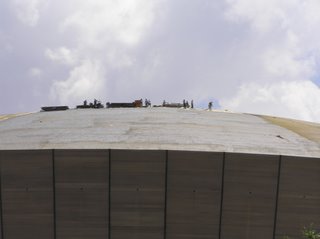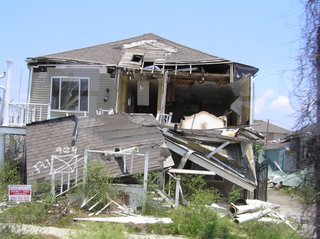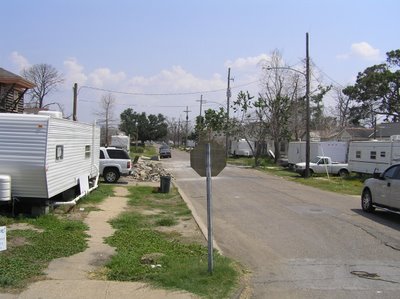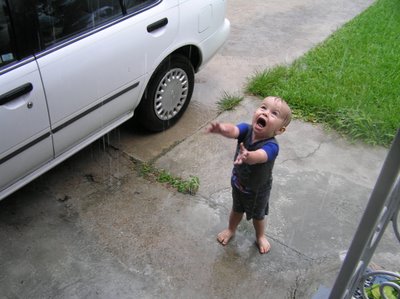Two weeks ago, Lori, Kirby and I went to New Orleans. My parents were going to check on their timeshare, and we decided to stay with them for a few days to get out of town and to see for ourselves what the city was like post-Katrina.
If somebody with no knowledge of last summer's catastrophe were magically transported to the historical heart of the city, Jackson Square, they would have no idea that just ten months ago the city was an apocalyptic morass of murky floodwater, rampant looting and unspeakable human suffering. They'd see the well-manicured grass and shrubs of the Square and the gleaming white towers of St. Louis Cathedral. They'd see the crowds at Cafe du Monde. They'd wander through the French Quarter and see the bars, the art galleries, the tourists milling about. They'd see that Bourbon Street is as raucous as ever. They'd walk back down Canal Street and see the streetcars trundling up and down the neutral ground, the families waiting to get into the Aquarium of the Americas, the high rollers strolling into Harrah's Casino.
They might not immediately notice that all the downtown hotels, while open, are short-staffed. They might not readily see that a lot of the restaurants are operating on shorter hours, and they might not instantly pay attention to all the "HELP WANTED" signs posted in the front of every store, every restaurant, every bar. They might ignore the bawdy "FEMA SUCKS" or "I VISITED NEW ORLEANS DURING KATRINA AND ALL I GOT WAS THIS LOUSY T-SHIRT (AND A HIGH-DEFINITION TV AND TEN ROLEX WATCHES AND A CADILLAC ESCALADE AND...)" t-shirts hanging in the fronts of all the stores. They might not notice the boarded-up facades of businesses that were looted or buildings that were burned in the lawlessness following the storm.
Indeed, things within the French Quarter and the Central Business District - two of the very few parts of town that did not flood following Katrina - are almost back to normal. But you don't have to travel too far in any direction from the central city before a different picture of New Orleans begins to emerge.
The city is busily trying to repair itself. The Port of New Orleans - the city's
raison d'être, because a port at the mouth of the Mississippi River is critical for the economic well-being of the United States - is almost completely operational. The tourists are returning. The two biggest emblems of t

he misery that the people of New Orleans suffered after the hurricane - the Superdome and the Morial Convention Center - are being renovated; when I was there workers were repairing the tattered roof of the Superdome and a huge banner on the side of the stadium announced the return of New Orleans Saints football in the fall. Bulldozers and cranes are everywhere, clearly indicating that a massive reconstruction effort is underway. But the city as a whole is still woefully crippled. The city's current population is by most estimates no more than half of what it was before Katrina struck. Educational facilities are sparse, and medical care within New Orleans itself is almost non-existent as most of the city's hospitals, heavily damaged by Katrina, remain closed.
A tour of the streets of neighborhoods like Lakeview or Gentilly reveals a

desolate landscape of house after house, street after street, neighborhood after neighborhood of gutted homes, FEMA trailers, debris piles, magnificent oaks and magnolias killed from all the saltwater, "we shoot looters on sight" signs, flooded cars and the like. Many houses still bear the spray-painted "X" of rescue personnel or the dark mark of the floodwater line. The block after block after block of uninterrupted destruction is hard to believe even when seen in person. A lot of people are rebuilding, but many other homes have literally been abandoned, as if their owners took the insurance settlement (provided they had insurance) and just walked away. It was a very eye-opening experience; I didn't tour the Lower Ninth Ward, but from what I've heard the level of destruction there is even worse.

The city's culture has changed, too. Turn on the local news and the top story invariably has something to do with FEMA, canal reconstruction, or some other relief effort. One local station has a regular weekly feature entitled "Fridays with FEMA" in which a Federal Emergency Management Agency representive takes phone calls and answers questions about tailers, payments, or other forms of aid. And the mere mention of a hurricane causes the city to collectively panic. Tropical Storm Alberto was at the top of all the local newscasts the entire time we were there, even though there was no expectation that it would get near the Louisiana coast. Repairs to the levees and the canals are not complete; the city really is at nature's mercy right now and the devastation that occurred last year could easily be repeated this year.
This is not to say that we didn't have a good time in New Orleans. The beignets at Cafe du Monde, the muffulletas at Central Grocery, the jambalaya at Mothers, the alcoholic concoctions on Bourbon Street are all as good as ever. We were glad to see that the Aquarium of the Americas was in operation again, and Kirby loved the sea otters. We perused handicrafts at the French Market, drank beer at the Crescent City Brewhouse, and enjoyed riding the streetcar up to the cemetaries and back on Canal Street (a service which is currently being operated by the venerable green St. Charles streetcars because the red Canal streetcars all got flooded and the entire St. Charles line is out of service even though their cars escaped unharmed).
But the reality remains: New Orleans post-Katrina is in many ways a completely different city than New Orleans pre-Katrina. The city is struggling to rebuild itself, but the road to recovery is long and there's still quite a way to go before any recovery can be considered "complete." Only time will tell if New Orleans will ever be quite the same as it was before September 2005. But this much is clear: Katrina, and its aftermath, will forevermore be a central part of this city's already-long history.
This article from the Heritage Trolley website is worth a read. It focuses on the situation regarding New Orleans' streetcar network but nevertheless contains many overall observations of New Orleans that are very similar to my own.




